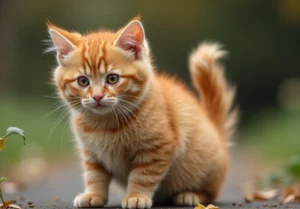Cats noses are often a delightful shade of pink, adding to their charm and appeal. But have you ever wondered why exactly their noses are this particular color? Let’s explore the fascinating reason behind why cats have pink noses.
Evolutionary Purpose
Have you ever wondered why cats have pink noses? Well, it turns out that there is an interesting evolutionary purpose behind this unique trait. One theory suggests that the pink hue of a cat’s nose may have developed over time as a way to regulate body temperature.
In the wild, cats may use their pink noses to help cool down their bodies when hunting or playing in hot climates. The pink color of their noses allows for efficient heat dissipation, helping them stay cool and focused on their activities. This evolutionary adaptation could have provided survival advantages for cats in warm environments.
Another interesting aspect to consider is that noses contain a network of blood vessels close to the surface, which can contribute to the pink coloring. This unique feature in cats may have also played a role in their evolutionary development, making them well-adapted to their surroundings. Overall, the pink noses of cats showcase the intriguing ways in which evolution has shaped these fascinating creatures.
Anatomy of a Cat’s Nose
When it comes to the anatomy of a cat’s nose, there are some distinct features that set it apart from other animals. Cats have a remarkably sensitive sense of smell, with specialized structures in their noses that help them detect scents with precision. This sophisticated olfactory system includes turbinate bones that enhance their smell, allowing them to navigate their environment effectively.
In addition to their olfactory abilities, cats also have unique nasal planum, which is the fleshy outer part of their noses. This area is covered in sensitive skin and hair follicles, giving cats a distinctive look. The pink color of their noses is due to a lack of melanin, the pigment responsible for coloring the skin. This lack of melanin results in the pink hue that cats are known for.
Overall, the anatomy of a cat’s nose is intricately designed to enhance their sense of smell and provide them with unique abilities. So, the next time you admire your feline friend’s pink nose, you’ll have a deeper appreciation for the complexity of their anatomical features.
Blood Flow and Temperature Regulation
Have you ever wondered why cats have pink noses? Well, the answer lies in their unique circulation system. A cat’s nose contains many tiny blood vessels that are close to the surface, giving it that lovely pink hue. This blood flow plays a crucial role in regulating their body temperature. When a cat is feeling warm, these blood vessels dilate to release heat, making their nose appear even pinker. Conversely, when they’re cold, these vessels constrict to conserve heat, causing their nose to pale slightly. So next time you see your feline friend with a rosy nose, just remember – it’s all about maintaining the purrfect temperature balance!
Hormonal Influence
In addition to blood flow, hormonal balance also plays a significant role in the color of a cat’s nose. Hormones such as estrogen and testosterone can impact the pigmentation of their nose, leading to variations in color. For example, a cat in heat may experience hormonal changes that result in a darker, more vibrant pink nose. Conversely, hormonal imbalances can cause paleness or discoloration. Ensuring your cat’s hormones are in check through proper diet and veterinary care can help maintain a healthy and pink nose. Remember, a happy cat means a healthy nose!
Additional Unique Insight:
Did you know that stress can also affect the color of a cat’s nose? Just like humans, felines can experience stress, which can impact their hormone levels and, consequently, the appearance of their nose. Providing a stress-free environment and plenty of love and attention can help keep your cat’s nose looking vibrant and pink.
Pink Noses in Different Cat Breeds
Did you know that the color of a cat’s nose can vary depending on its breed? While many cats have pink noses, some breeds have different colored noses, such as black, orange, or even spotted. This variation is due to genetics and the pigmentation of the cat’s skin. For example, Siamese cats often have pink noses, while Bombay cats typically have black noses. So, don’t be surprised if you come across a cat with a nose that’s not the classic pink – it’s just a part of their unique breed characteristics.
Common Myths Debunked
Let’s put some common myths about cat nose color to rest. One common misconception is that a cat’s nose turns pink when it’s sick or unhealthy. In reality, a healthy cat can have a pink nose just as a sign of good health. Another myth is that a cat’s nose always changes color based on its mood. While a cat’s nose can change color slightly due to blood flow or environmental factors, it doesn’t serve as a reliable indicator of their emotional state. So, rest assured that your cat’s nose color doesn’t determine their health or mood.
List of Cat Breeds with Different Nose Colors: 1. Siamese – Pink nose 2. Bombay – Black nose 3. Bengal – Spotted nose 4. Sphynx – Pink or mottled nose
Remember, every cat is unique, and their nose color is just one tiny part of what makes them special.
Health Indicators in Nose Color
Did you know that the color of a cat’s nose can actually be a good indicator of their overall health? A pink nose is typically a sign of a healthy cat, while a change in color could signal an underlying issue. If your cat’s nose suddenly changes color or becomes discolored, it might be a good idea to consult your veterinarian to rule out any health problems.
Fun fact: Cats have a unique system of scent glands in their noses that help them mark their territory. So, not only is their pink nose cute, but it also serves a practical purpose in communicating with other cats!
Fun Facts About Cat Noses
You might be surprised to learn that a cat’s nose is as unique as a human fingerprint. Each cat has a distinctive nose pad pattern that is as individual as they are. So, next time you’re snuggled up with your furry friend, take a moment to appreciate their one-of-a-kind nose!
Cats have a special organ located above the roof of their mouth called the vomeronasal organ, also known as Jacobson’s organ. This organ helps cats process pheromones, which are chemical signals used for communication between cats.
While most cats have pink noses, some breeds, like the Siamese cat, can have darker-colored noses. This difference in nose color is due to the amount of pigment in their skin.
Cats’ noses are incredibly sensitive and contain up to 200 million scent receptors, compared to a human’s mere 5 million. This makes them excellent hunters and allows them to detect subtle changes in their environment.
Keep in mind that monitoring your cat’s nose color and overall health can be a simple and effective way to ensure they are happy and healthy. And don’t forget to show a little love to that adorable pink nose of theirs!
Unique Adaptations in Cats
Have you ever stopped to wonder why cats have pink noses? Well, let’s dive into the fascinating world of cat adaptations to shed some light on this unique feature. Cats’ noses are pink due to a lack of melanin, the pigment responsible for coloring skin and fur. This lack of pigment in their noses allows for better absorption of sunlight, aiding in the production of Vitamin D. So, that cute little pink nose isn’t just for looks – it plays a crucial role in keeping your feline friend healthy and happy.
One intriguing fact about cats’ noses is that they serve as a cooling system. Cats do not have sweat glands all over their bodies like humans do, so they rely on other methods to regulate their body temperature. The capillaries in their pink noses help dissipate heat, keeping them cool even in hot weather. Next time you see your cat basking in the sun with its pink nose glistening, know that it’s not just for show – it’s all part of their clever design to stay comfortable.
Cats’ noses are also equipped with a unique feature called the Jacobson’s organ, or the vomeronasal organ. This special sensory organ allows cats to detect pheromones, helping them communicate and navigate their environment. So, it’s not just about the color – cats’ noses are essential tools for survival and interaction in the world around them. The next time you admire your feline friend’s pink nose, remember that it’s not just a cute accessory – it’s a vital part of what makes them such fascinating creatures.
Alex, a passionate animal lover, has experience in training and understanding animal behavior. As a proud pet parent to two dogs and three cats, he founded AnimalReport.net to share insights from animal experts and expand his knowledge of the animal kingdom.




